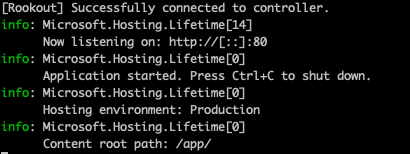Deploy Rookout on a .NET container
This short tutorial will walk you through the perfect Rookout deployment for containerized .NET applications in four quick steps.
Get Your Application
First things first, choose an application. If you don't have one readily available, use our sample application.
Start by:
git clone https://github.com/Rookout/dotnet-tutorial-2022
cd dotnet-tutorial-2022
1. Add the NuGet Package
Rookout for .NET is a simple NuGet Package.
Go ahead and add it as a dependency:
dotnet add package Rookout
2. Start Rookout
Load and start the package to connect to your Rookout account (if you haven't signed up, do that here).
Start the SDK within your application by adding the following to your main method or your application's entry point. In our case, Program.cs:
using Rook;
Rook.RookOptions options = new Rook.RookOptions()
{
token = "[Your Rookout Token]",
labels = new Dictionary<string, string> { { "env", "dev" } }
};
Rook.API.Start(options);
// ...
Configuration is where you can get fancy. You have got additional options up your sleeve:
- Move options to secret or configuration managers.
- If you are using Rookout's hybrid architecture, set up the controller's host configuration.
- Dig deeper into other options available right here.
3. Configure Build Settings
For the best and most reliable debugging experience, add a couple of settings to your .csproj file(s):
- Set the debug information format to
portable. - Embed sources in the PDB file for verification.
<DebugType>portable</DebugType>
<EmbedAllSources>true</EmbedAllSources>
4. Embed Source Information
Rookout offers the smoothest debugging experience by displaying up-to-date source code for each server.
Set this up for containerized applications by adding a handful of files from your .git folder to the container image.
Edit (or add) your .dockerignore file and adapt the traditional .git exclude:
# Keep ignoring .git
.git
# Allow specific files with !
!.git/HEAD
!.git/config
!.git/refs
Add a COPY command to the end of the Dockerfile, just above the ENTRYPOINT.
COPY .git /.git
Note: in multi-stage builds (like ours), make all your changes on the final stage.
Test
One second! if you are not using our demo app, please commit and push your changes to a new branch.
Build and run your Docker image:
docker build . -t rookout-dotnet-todo
docker run -it -p 8080:80 rookout-dotnet-todo
As your .NET application spins up, search for this output at the top:

Interact with your application at http://localhost:8080 and use Rookout to debug it on the fly!
Questions?
- Check out this reference implementation.
- Dig into our .Net docs.
- Reach out to us via chat or email.